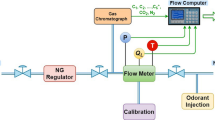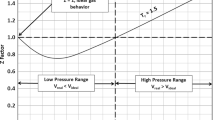Abstract
This research illustrates the utilization of a new model based on artificial neural networks (ANNs) in prediction of compressibility factor (z-factor) of natural gases using experimental data based on Standing and Katz z-factor diagram. Although equations of state and empirical correlations have been applied for predicting compressibility factor, the demands for the modern, more reliable and easy-to-use models encouraged the researchers to recommend modern facilities such as intelligent systems. This investigation describes a new technique for computing z-factor of natural gases. The base of the approach is ANN in which a 2:5:5:1 structure is used as an optimum network to predict the z-factor. The statistical results show that the developed ANN is an excellent tool for estimating z-factor values; therefore, it can be confidently used for natural gases with various compositions at a specific temperature and pressure.







Similar content being viewed by others
References
Azizi N, Behbahani R, Isazadeh MA (2010) An efficient correlation for calculating compressibility factor of natural gases. J Nat Gas Chem 19(6):642–645
Raja MAZ, Farooq U, Chaudhary NI, Wazwaz AM (2016) Stochastic numerical solver for nanofluidic problems containing multi-walled carbon nanotubes. Appl Soft Comput 38:561–586. doi:10.1016/j.asoc.2015.10.015
Ahmad I, Raja MAZ, Bilal M, Ashraf F (2016) Bio-inspired computational heuristics to study lane–Emden systems arising in astrophysics model. SpringerPlus 5(1):1866
Raja MAZ, Shah FH, Tariq M, Ahmad I (2016) Design of artificial neural network models optimized with sequential quadratic programming to study the dynamics of nonlinear Troesch’s problem arising in plasma physics. Neural Computing and Applications:1–27
Raja MAZ, Shah FH, Alaidarous ES, Syam MI (2016) Design of bio-inspired heuristic technique integrated with interior-point algorithm to analyze the dynamics of heartbeat model. Applied Soft Computing
Raja MAZ, Shah AA, Mehmood A, Chaudhary NI, Aslam MS (2016) Bio-inspired computational heuristics for parameter estimation of nonlinear Hammerstein controlled autoregressive system. Neural Computing and Applications:1–20
Ahmad I, Ahmad F, Raja MAZ, Ilyas H, Anwar N, Azad Z Intelligent computing to solve fifth-order boundary value problem arising in induction motor models. Neural Computing and Applications:1–18
Masood Z, Majeed K, Samar R, Raja MAZ (2017) Design of Mexican Hat Wavelet neural networks for solving Bratu type nonlinear systems. Neurocomputing 221:1–14
Mohanty S (2006) Estimation of vapour liquid equilibria for the system carbon dioxide-difluoromethane using artificial neural networks. Int J Refrig 29(2):243–249
Mohanty S (2005) Estimation of vapour liquid equilibria of binary systems, carbon dioxide-ethyl caproate, ethyl caprylate and ethyl caprate using artificial neural networks. Fluid Phase Equilib 235(1):92–98
Normandin A, Grandjean BPA, Thibault J (1993) PVT data analysis using neural network models. Ind Eng Chem Res 32(5):970–975. doi:10.1021/ie00017a029
Kamyab M, Sampaio JHB Jr, Qanbari F, Eustes Iii AW (2010) Using artificial neural networks to estimate the z-factor for natural hydrocarbon gases. J Pet Sci Eng 73(3–4):248–257
Rezakazemi M, Ghafarinazari A, Shirazian S, Khoshsima A (2013) Numerical modeling and optimization of wastewater treatment using porous polymeric membranes. Polym Eng Sci 53(6):1272–1278. doi:10.1002/pen.23375
Rezakazemi M, Mohammadi T (2013) Gas sorption in H2-selective mixed matrix membranes: experimental and neural network modeling. Int J Hydrog Energy 38(32):14035–14041. doi:10.1016/j.ijhydene.2013.08.062
Rostamizadeh M, Rezakazemi M, Shahidi K, Mohammadi T (2013) Gas permeation through H2-selective mixed matrix membranes: experimental and neural network modeling. Int J Hydrog Energy 38(2):1128–1135. doi:10.1016/j.ijhydene.2012.10.069
Farno E, Rezakazemi M, Mohammadi T, Kasiri N (2014) Ternary gas permeation through synthesized pdms membranes: experimental and CFD simulation basedon sorption-dependent system using neural network model. Polym Eng Sci 54(1):215–226. doi:10.1002/pen.23555
Rezakazemi M, Razavi S, Mohammadi T, Nazari AG (2011) Simulation and determination of optimum conditions of pervaporative dehydration of isopropanol process using synthesized PVA–APTEOS/TEOS nanocomposite membranes by means of expert systems. J Membr Sci 379(1–2):224–232. doi:10.1016/j.memsci.2011.05.070
Demuth H, Beale M (1998) Neural network toolbox for use with MATLAB. The MathWorks, Inc., Massachusetts
Dogan E, Ates A, Yilmaz EC, Eren B (2008) Application of artificial neural networks to estimate wastewater treatment plant inlet biochemical oxygen demand. Environ Prog 27(4):439–446
Jarrahian A, Heidaryan E (2014) A new cubic equation of state for sweet and sour natural gases even when composition is unknown. Fuel 134:333–342
Kamari A, Gharagheizi F, Mohammadi AH, Ramjugernath D (2016) A corresponding states-based method for the estimation of natural gas compressibility factors. J Mol Liq 216:25–34
Fatoorehchi H, Abolghasemi H, Rach R (2014) An accurate explicit form of the Hankinson–Thomas–Phillips correlation for prediction of the natural gas compressibility factor. J Pet Sci Eng 117:46–53
Stewart W, Burkhardt S (1959) Voo D prediction of pseudo-critical parameters for mixtures. AIChE Meeting, Kansas City, MO
Sutton RP (2007) Fundamental PVT calculations for associated and gas/condensate natural-gas systems. SPE Reserv Eval Eng 10(03):270–284
Yarborough L, Hall KR (1973) A new EOS for Z-factor calculations. Oil & Gas Journal 71(7):82–92
Dranchuk PM, Abou-Kassem JH (1975) Calculation of Z factors for natural gases using equations of state. J Can Pet Technol 14(3):34–36
Al-Khamis MN (1995) Evaluation of correlations for natural gas compressibility factors. King Fahd University of Petroleum and Minerals, Dhahran
Kumar N (2004) Compressibility factors for natural and sour reservoir gases by correlations and cubic equations of state. Texas Tech University, Lubbock
Brill J, Beggs H (1974) University of Tulsa: “two phase flow in pipes”. Intercomp Course, The Hague
Kareem LA, Iwalewa TM, Al-Marhoun M (2015) New explicit correlation for the compressibility factor of natural gas: linearized z-factor isotherms. Journal of Petroleum Exploration and Production Technology:1–12
Kamari A, Hemmati-Sarapardeh A, Mirabbasi S-M, Nikookar M, Mohammadi AH (2013) Prediction of sour gas compressibility factor using an intelligent approach. Fuel Process Technol 116:209–216
Raja MAZ, Shah FH, Khan AA, Khan NA (2016) Design of bio-inspired computational intelligence technique for solving steady thin film flow of Johnson–Segalman fluid on vertical cylinder for drainage problems. J Taiwan Inst Chem Eng 60:59–75
Raja MAZ, Zameer A, Khan AU, Wazwaz AM (2016) A new numerical approach to solve Thomas–Fermi model of an atom using bio-inspired heuristics integrated with sequential quadratic programming. SpringerPlus 5(1):1400
Ahmad I, Raja MAZ, Bilal M, Ashraf F Neural network methods to solve the Lane–Emden type equations arising in thermodynamic studies of the spherical gas cloud model. Neural Computing and Applications:1–16
Nazari AG, Mozafari M (2012) Simulation of structural features on mechanochemical synthesis of Al 2 O 3–TiB 2 nanocomposite by optimized artificial neural network. Adv Powder Technol 23(2):220–227
Sapuan SM, Mujtaba IM (2010) Composite materials technology neural network applications. CRC Press, Florida
Author information
Authors and Affiliations
Corresponding author
Ethics declarations
Conflict of interest
The authors declare that they have no conflict of interest.
Rights and permissions
About this article
Cite this article
Azizi, N., Rezakazemi, M. & Zarei, M.M. An intelligent approach to predict gas compressibility factor using neural network model. Neural Comput & Applic 31, 55–64 (2019). https://doi.org/10.1007/s00521-017-2979-7
Received:
Accepted:
Published:
Issue Date:
DOI: https://doi.org/10.1007/s00521-017-2979-7




